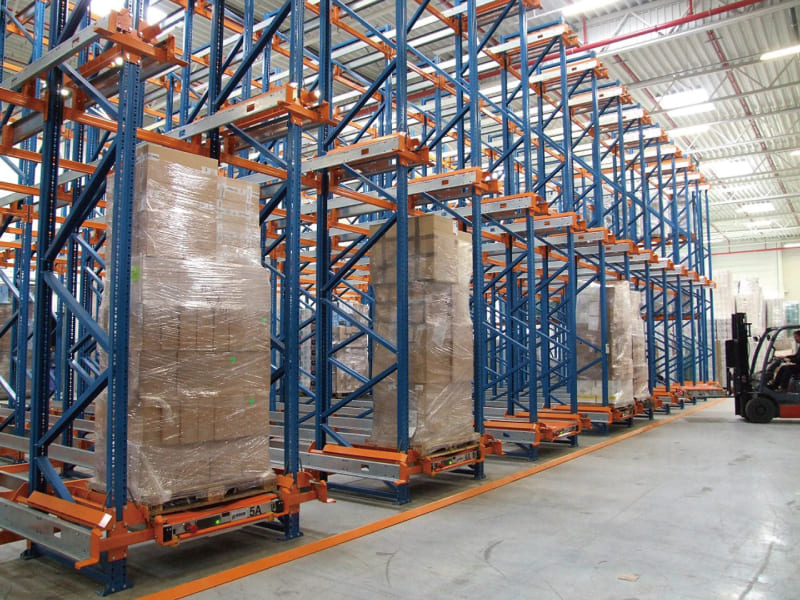A نظام نقل المستودعات هي عربة آلية متنقلة مصممة لنقل البضائع داخل المستودع، خاصة داخل أنظمة الأرفف العميقة. تتحرك هذه المكوكات على طول القضبان المدمجة في هيكل الأرفف، وتتعامل بكفاءة مع استرجاع وتخزين العناصر مثل المنصات أو الصواني أو حقائب اليد.
تتيح لهم إمكانية التنقل تحسين معدل استخدام مساحة المستودع من خلال التمكين تخزين عالي الكثافة، وتعظيم المساحة العمودية، وتقليل الحاجة إلى ممرات واسعة.

تتفوق هذه الأنظمة في العمليات التي تستخدم البضائع إلى شخص النموذج، حيث يتم إحضار العناصر إلى العمال للمعالجة أو تنفيذ الطلب. وهذا يعني أن أنظمة النقل المكوكية للمستودعات تكون فعالة بشكل خاص في الإعدادات التي تحتوي على عدد أقل من وحدات SKU ولكن إنتاجية عالية، حيث يكون التحميل والتفريغ السريع للمنصات أمرًا ضروريًا. فهي تساهم في سير العمل بشكل أكثر سلاسة وتقليل العمل اليدوي وسلامة الموظفين.
تعمل أنظمة النقل المكوكية للمستودعات عادةً في أحد التكوينين:
بمجرد وضع المنصات على أحد طرفي نظام الأرفف، يستخدمها المشغلون التحكم عن بعد أو واي فاي إشارات لتوجيه المكوك. يقوم المكوك باسترداد أو إيداع المنصات عن طريق التحرك على طول القضبان إلى موضع التخزين الصحيح. غالبًا ما يتم تركيب الناقلات العمودية أو مصاعد المستودعات في نهاية الممر، مما يتيح للمكوك التنقل بين مستويات الأرفف المختلفة لتحقيق الاستخدام الأمثل للمساحة.
الميزات الرئيسية لأنظمة نقل المستودعات

فوائد أنظمة نقل المستودعات
توفر أنظمة نقل المستودعات العديد من المزايا التي تلبي احتياجات إدارة المستودعات الحديثة:
تعمل أنظمة نقل المستودعات على تحسين كفاءة التخزين بشكل كبير من خلال تمكين الأرفف عالية الكثافة. يمكن أن تقلل المستودعات المسافة بين الممرات وتزيد من ارتفاع هياكل الأرفف الخاصة بها، مما يجعلها مفيدة في المرافق التي تكون فيها المساحة محدودة أو باهظة الثمن.
بالنسبة للمستودعات التي تتعامل مع كميات كبيرة من وحدات SKU المماثلة (وحدات حفظ المخزون)، تسمح هذه الأنظمة بالاسترجاع السريع ووضع المنصات. أنها تبسيط تنفيذ الطلب العمليات عن طريق تقليل التأخير في انتقاء وتخزين البضائع. هذه الميزة تجعل أنظمة النقل المكوكية خيارًا مفضلاً لصناعات مثل الطعام والشراب, التخزين البارد، و تجهيز اللحوم، حيث تعد الإنتاجية أمرًا بالغ الأهمية.
تعمل الأتمتة التي توفرها أنظمة نقل المستودعات على تقليل الحاجة إلى التدخل اليدوي في التعامل مع المنصات. مطلوب عدد أقل من المشغلين لإدارة النظام، مما يؤدي إلى انخفاض تكاليف العمالة. بالإضافة إلى ذلك، تقلل الأتمتة من المخاطر المرتبطة بالتعامل اليدوي، مما يعزز السلامة في مكان العمل.
يقلل تصميم أنظمة نقل المستودعات من الحاجة إلى دخول الرافعات الشوكية إلى مناطق الأرفف، مما يقلل الازدحام واحتمال وقوع الحوادث. علاوة على ذلك، من خلال أتمتة التعامل مع المنصات، تمنع الأنظمة تلف البضائع وهياكل الأرفف، مما يؤدي إلى وفورات طويلة الأجل وإدارة أفضل للأصول.
تتيح أنظمة نقل المستودعات تحميل وتفريغ المنصات بشكل أسرع. من خلال تقليل الوقت المستغرق في نقل البضائع داخل وخارج التخزين، يمكن للمستودعات معالجة الطلبات بسرعة أكبر، مما يؤدي إلى رضا العملاء بشكل أفضل وتدفق أكثر كفاءة.
على الرغم من فوائدها العديدة، فإن أنظمة نقل المستودعات تأتي مع بعض القيود التي يجب مراعاتها قبل التنفيذ:
واحدة من العيوب الرئيسية هي التكلفة الأولية الكبيرة. تتطلب أنظمة نقل المستودعات استثمارًا رأسماليًا كبيرًا في معدات التشغيل الآلي للمستودعات والبنية التحتية. يجب على الشركات أن تزن العائد المحتمل على الاستثمار (ROI) قبل الالتزام بمثل هذا النظام.
نظرًا لآلياتها المعقدة وأتمتتها، فإن هذه الأنظمة تتطلب متطلبات صيانة عالية. تعتبر الخدمة المنتظمة وفترات التوقف العرضية ضرورية لضمان الأداء الأمثل، الأمر الذي قد يؤدي إلى تعطيل عمليات المستودع.
تعتبر أنظمة النقل المكوكية للمستودعات مناسبة بشكل أفضل للمنشآت ذات مجموعة محدودة من وحدات SKU التي تحتاج إلى تخزينها بكميات كبيرة. فهي ليست مثالية للبيئات ذات ممرات SKU متعددة أو العمليات التي تتطلب قطف القطعة. مع استمرار التجارة الإلكترونية في زيادة الطلب على مجموعات المنتجات المتنوعة للغاية، فإن هذا القيد يجعل أنظمة نقل المستودعات أقل ملاءمة للعديد من المستودعات الحديثة.
للحصول على أقصى استفادة من نظام نقل المستودعات، من الضروري تقييم الاحتياجات المحددة لبيئة المستودع:

بالنسبة للمنشآت التي تدير وحدات SKU متنوعة أو تتطلب المزيد من المرونة في اختيار العمليات، الروبوتات المتنقلة التعاونية (الروبوتات) قد تكون خيارًا أفضل. الروبوتات التعاونية، مثل تلك المستخدمة في التجارة الإلكترونية أو مراكز الوفاء متعددة القنوات، تم تصميمها للتنقل في بيئات المستودعات بشكل مستقل، واختيار البضائع ونقلها. تعد هذه الروبوتات أكثر قدرة على التكيف مع عمليات الانتقاء المعقدة وتوفر مزايا مقارنة بأنظمة نقل المستودعات، مثل:
أنظمة نقل المستودعات تقليل تكاليف العمالة، وتسريع عمليات التعامل مع المنصات بشكل كبير. ومع ذلك، فإنه قد يلبي كميات أكبر من وحدات SKU المماثلة.
إذا كنت أود لأتمتة عملية المستودع الخاص بك والحصول على عرض أسعار، لا تتردد في ذلك اتصل بنا الآن، فريق الخبراء لدينا على استعداد للعثور على أفضل ما يناسب مستودعك.
حقوق النشر
© 2024 Jiangsu Vijing Logistics Technology Co., Ltd. كل الحقوق محفوظة.
 الشبكة المدعومة
الشبكة المدعومة
خريطة الموقع | المدونة | Xml | سياسة الخصوصية